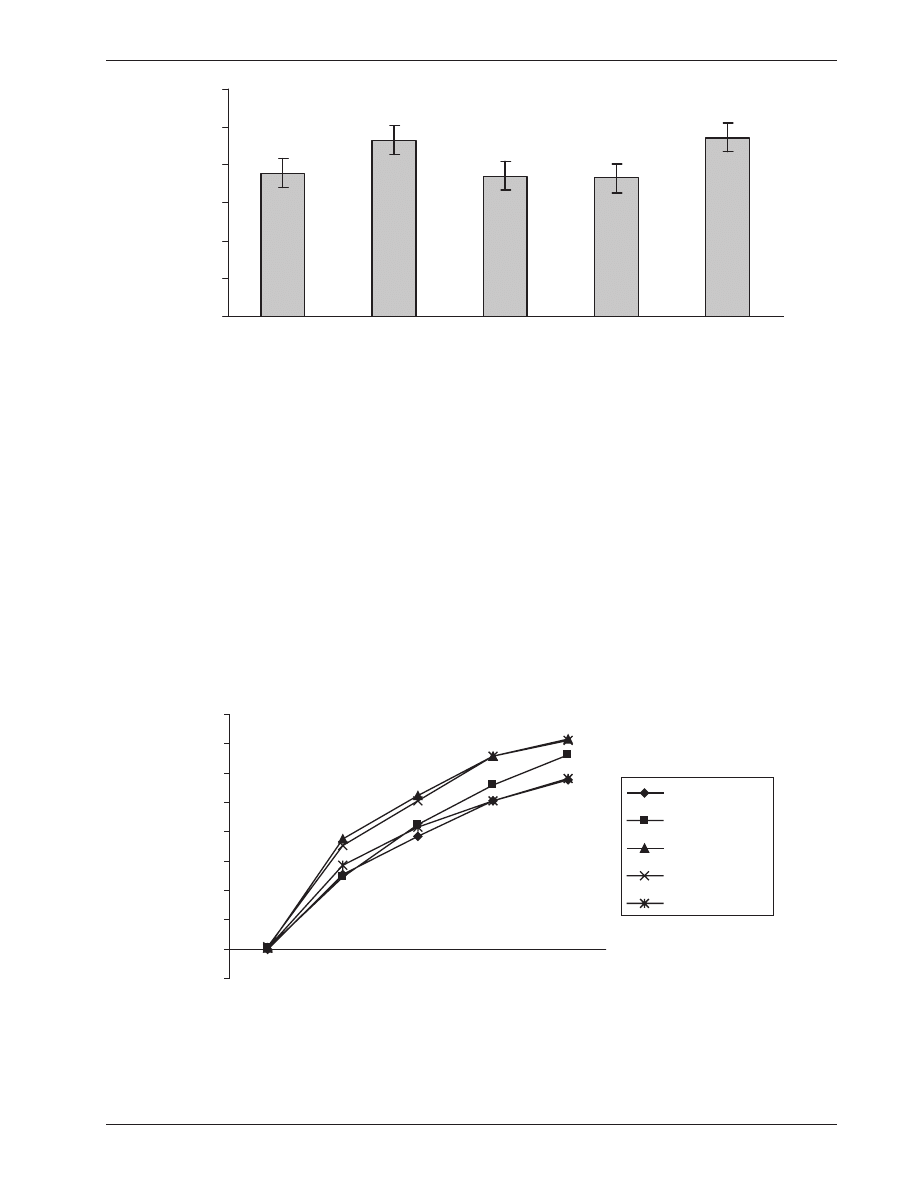
© 2008 Bialosky et al, publisher and licensee Dove Medical Press Ltd. This is an Open Access article
which permits unrestricted noncommercial use, provided the original work is properly cited.
Journal of Pain Research 2008:1 35–41
35
O R I G I N A L R E S E A R C H
Manipulation of pain catastrophizing: An experimental
study of healthy participants
Joel E Bialosky
1*
Adam T Hirsh
2,3
Michael E Robinson
2,3
Steven Z George
1,3*
1
Department of Physical Therapy;
2
Department of Clinical and Health
Psychology;
3
Center for Pain Research
and Behavioral Health, University of
Florida, Gainesville, Florida, USA
Correspondence: Steven Z George
Health Science Center, PO Box 100154,
Gainesville, FL 32610-0154, USA
Tel
+1 352 273 6432
Fax
+1 352 273 6109
Email szgeorge@phhp.ufl .edu
Abstract: Pain catastrophizing is associated with the pain experience; however, causation
has not been established. Studies which specifi cally manipulate catastrophizing are necessary
to establish causation. The present study enrolled 100 healthy individuals. Participants were
randomly assigned to repeat a positive, neutral, or one of three catastrophizing statements during
a cold pressor task (CPT). Outcome measures of pain tolerance and pain intensity were recorded.
No change was noted in catastrophizing immediately following the CPT (F
(1,84)
= 0.10, p = 0.75,
partial
η
2
⬍ 0.01) independent of group assignment (F
(4,84)
= 0.78, p = 0.54, partial η
2
= 0.04).
Pain tolerance (F
(4)
= 0.67, p = 0.62, partial η
2
= 0.03) and pain intensity (F
(4)
= 0.73, p = 0.58,
partial
η
2
= 0.03) did not differ by group. This study suggests catastrophizing may be diffi cult
to manipulate through experimental pain procedures and repetition of specifi c catastrophizing
statements was not suffi cient to change levels of catastrophizing. Additionally, pain tolerance
and pain intensity did not differ by group assignment. This study has implications for future
studies attempting to experimentally manipulate pain catastrophizing.
Keywords: pain, catastrophizing, experimental, cold pressor task, pain catastrophizing scale
Pain catastrophizing is “an exaggerated negative orientation toward noxious stimuli”
(Sullivan et al 1995) and is associated with heightened pain response in both clinical
(Severeijns et al 2001; Tan et al 2001) and experimental (Geisser et al 1992; Sullivan
et al 1995; Osman et al 1997) pain studies. For example, catastrophizing has been
associated with pain intensity and disability in individuals with chronic pain (Severeijns
et al 2001; Peters et al 2005). Additionally, catastrophizing is associated with a
heightened pain response during a cold pressor task (CPT) in healthy individuals
(Sullivan et al 1995). Although these studies demonstrate a robust association between
catastrophizing and pain, their cross-sectional nature limits interpretations regarding
causation.
Prospective studies indicate a temporal association between catastrophizing and
pain and are more suggestive of causation. For example, preoperative measures of
catastrophizing are predictive of postoperative pain intensity (Granot and Ferber
2005; Pavlin et al 2005), and catastrophizing measured during acute dental pain is
predictive of thermal pain threshold and tolerance upon resolution of the dental pain
(Edwards et al 2004).
A limitation of the current literature is the lack of studies which specifi cally
manipulate catastrophizing to determine its effect on pain. Such study designs are
necessary in order to strengthen conclusions about causation. To our knowledge, only
one prior study has attempted to manipulate catastrophizing during an experimental
pain task (Severeijns et al 2005). Severeijns and colleagues (2005) manipulated
catastrophizing by increasing the threat of the stimulus (ie, a risk of passing out during a
CPT) for healthy participants. A small increase in catastrophizing was noted following

Journal of Pain Research 2008:1
36
Bialosky et al
the instructional set; however, no group differences in pain
intensity or tolerance were noted during the CPT.
A potential limitation of the study by Severeijns and
colleagues (2005) was the attempt to manipulate catastroph-
izing through exaggerated threat level. Catastrophizing is
comprised of cognitions related to rumination, helplessness,
and magnifi cation (Sullivan et al 1995, 2001; Osman et al
1997; Van Damme et al 2002). These cognitions were not
specifi cally manipulated in the Severeijns and colleagues
(2005) study. Experimental manipulation of catatastrophiz-
ing may require attention to these specifi c cognitions in
order to meaningfully alter catastrophizing and infl uence
subsequent pain responses. We are unaware of any prior
studies which have adopted such methodology to study the
effect of catastrophizing on pain.
Therefore, the current study had two purposes. The fi rst
was to determine whether pain catastrophizing could be
successfully manipulated through the repetition of rumi-
nation, helplessness, and magnification catastrophizing
statements. We hypothesized that individuals repeating
statements consistent with the construct of catastrophizing
would have higher scores on measures of pain catastroph-
izing immediately following a CPT than those repeating a
positive and neutral statement. The second purpose was to
assess the effect of rumination, helplessness, and magnifi -
cation statements on pain intensity and tolerance during a
CPT. We hypothesized that repeating a pain catastrophizing
statement would result in higher ratings of pain intensity and
lower tolerance to a CPT.
Methods
Participants
The present study was approved by the University of
Florida Institutional Review Board. Participants between
the ages of 18 and 25 were recruited from the University
of Florida Health Science Center by fl yers and word of
mouth. Individuals currently experiencing pain or taking
pain medication were excluded, as were non-English
speaking individuals. Participants meeting the inclusion/
exclusion criteria and agreeing to participate signed an
informed consent form and completed the following
questionnaires.
Measures
Demographics form
Information was obtained pertaining to the participants’
sex, age, ethnicity, educational level, and prior experience
with the CPT.
Pain catastrophizing scale
The Pain Catastrophizing Scale (PCS) (Sullivan et al
1995) is comprised of 13 items specifi c to coping with
pain and makes use of a fi ve point ordinal scale from
0 to 4. Subjects are asked to quantify each statement
in terms of its applicability towards a previous painful
episode, with higher scores indicating a greater level of
catastrophizing. A total score and three subscale scores
consisting of rumination, magnifi cation, and helplessness,
may be calculated. Prior studies have validated the factor
structure and found good internal consistency, reliability,
and validity (Sullivan et al 1995; Osman et al 1997; Van
Damme et al 2002).
Fear of pain questionnaire (FQP-III)
The FPQ-III (McNeil and Rainwater 1998) consists of
30 items, each scored on a 5-point adjectival scale, which
measures fear of normally painful situations. Higher scores
indicate greater pain related fear. The FPQ has demon-
strated sound psychometric properties in both experimental
and clinical pain studies (McNeil and Rainwater 1998;
Osman et al 2002; Roelofs et al 2005). Fear of pain has
been previously shown to infl uence CPT pain (Keogh
et al 2003; Sullivan et al 2004; George et al 2006) and
we wished to be certain our randomization process was
successful in preventing group differences in baseline
fear of pain.
Group assignment
Participants were randomly assigned to repeat one of fi ve
statements during the CPT. The catastrophizing statements
were taken directly from the PCS and selected based on the
strength of their factor loading to each respective construct
(Sullivan et al 1995).
Pain Catastrophizing Group 1: Received a statement
consistent with magnifi cation and were instructed to repeat
the statement, “I fear the pain will get worse.”
Pain Catastrophizing Group 2: Received a statement
consistent with helplessness and were instructed to repeat
the statement, “I fear I can’t go on.”
Pain Catastrophizing Group 3: Received a statement
consistent with rumination and were instructed to repeat the
statement, “I keep thinking how badly I want the pain
to stop.”
Positive Statement Group: This group was instructed to
repeat the statement, “I can overcome the pain.”
Neutral Statement Group: This group was instructed to
repeat the statement, “The sky is blue.”

Journal of Pain Research 2008:1
37
Manipulation of pain catastrophizing
Procedure
Participants provided informed consent and then completed
the demographic form, the PCS, and the FPQ-III. Next,
participants were instructed in the use of the Visual Analog
Scale (VAS). The VAS consists of a horizontal 10 cm
line anchored by “no pain” and “worst pain imaginable.”
Participants were instructed to make a vertical mark along the
horizontal line to indicate their pain rating during the study
whenever a VAS was placed in front of them. VASs of pain
are signifi cantly correlated with other measures of pain and
have been widely used in experimental pain studies (Jensen
et al 1986; Good et al 2001). Participants were asked to mark
their baseline rating of pain on a VAS prior to the CPT to
ensure understanding of the use of the VAS and that they were
currently pain free. Participants were then randomly assigned
to repeat one of the fi ve statements aloud during the CPT. The
assigned statement was then fi xed to the wall in front of the
participant who was asked to read the statement aloud two
times and instructed that they would continually repeat the
statement aloud for the duration of the CPT. The following
statement was then provided regarding the cold pressor.
“I will ask you to submerge your NON-DOMINANT hand,
up to your wrist, into this container of water. You can
remove your hand from the water when you can no longer
tolerate the pain, but it is important that you leave your
hand in the water as long as you possibly can. Do you
understand what to do?”
Upon verbalization of understanding of the study protocol,
participants were instructed to place their hand into the cold pres-
sor. The CPT consisted of a circulating water bath maintained at
2
°C (± 0.5 °C). Participants repeated their assigned statement
aloud beginning immediately upon placement of their hand into
the cold pressor. Pain ratings were recorded via the VAS at the
onset of pain and every 15 seconds following the initiation of
the CPT. The examiner indicated the need to complete a VAS
by placing a clean one in front of the participant every fi fteen
seconds from the initiation of the CPT and when the participant
withdrew from the CPT. Completed VASs were immediately
removed by the researcher and out of sight of participants
completing subsequent VASs. Participants not removing their
hand from the CPT by 3 minutes were instructed to remove their
hand by the investigator. Following the CPT, participants again
completed the PCS with instruction to have responses refl ect
what they were experiencing during the CPT.
Data analysis
Descriptive statistics were generated for continuous and
categorical measures. Univariate ANOVA was used to assess
post-randomization differences in continuous variables
of demographic and psychological measures. Chi-square
analysis was used to assess post-randomization group
differences in categorical demographic variables.
First, we used Pearson correlation coeffi cients to examine
whether an association existed between both pre and post
CPT measures of pain catastrophizing and pain intensity
and tolerance. Next we analyzed pain catastrophizing and
whether this was infl uenced by group assignment using a
2
× 5 repeated measure ANOVA. PCS score at baseline and
immediately following the CPT served as the within subject
factor while group assignment was the between subject
factor. Post hoc testing using Bonferroni correction was
performed as indicated by the ANOVA model.
Individual univariate ANOVA models were used to
assess the effect of group assignment on both pain tolerance
and rating of pain intensity provided by the participant at
the time of withdrawal from the CPT (tolerance), with post
hoc testing using Bonferroni correction as indicated by the
ANOVA model. Finally, repeated measure ANOVA was
used to test the effect of group assignment on pain perception
at fi fteen second increments from baseline to one minute. This
exploratory analysis was performed only on subjects that tol-
erated the CPT for one minute. Its purpose was to determine
if there were any group differences in pain intensity ratings
before tolerance because we were concerned that a ceiling
effect might exist for pain intensity ratings at tolerance.
Results
100 subjects met the criteria and consented to participate in
the study. No baseline differences were observed between
the groups in demographic characteristics; however, fear of
pain approached signifi cance (Table 1), so the decision was
made to include this as a covariate in subsequent analysis. Pre
CPT PCS scores were not signifi cantly correlated with pain
intensity (r
= 0.05, p = 0.59) or tolerance (r = −0.12, p = 0.25).
Furthermore, post CPT PCS scores were not signifi cantly
correlated with pain intensity (r
= 0.12, p = 0.25); however,
a signifi cant correlation was observed between post CPT PCS
scores and pain tolerance (r
= −0.31, p ⬍ 0.01).
Purpose 1: Effect of coping statement
on self-report of pain catastrophizing
In the model without controlling for fear of pain, a group
× time
(pre to post CPT) interaction for change in PCS scores was not
present (F
(4,95)
= 0.94, p = 0.45, partial η
2
= 0.04); however, a main
effect for assessment time was observed (F
(1,95)
= 5.52, p = 0.02,
partial
η
2
= 0.06), with higher PCS scores following the CPT

Journal of Pain Research 2008:1
38
Bialosky et al
(mean difference 2.00, SD
= 8.49, p = 0.02, effect size = 0.24).
When fear of pain was included in the model as a covariate
(due to potential post randomization differences), neither a
group
× time (pre- to post-CPT) interaction (F
(4,84)
= 0.78,
p
= 0.54, partial η
2
= 0.04); nor a main effect for assessment time
(F
(1,84)
= 0.10, p = 0.75, partial η
2
⬍ 0.01) was observed for change
in PCS scores. Due to the lack of a group effect for total PCS
scores, we further investigated whether group assignment had a
specifi c effect on individual constructs of the PCS. For example,
we considered whether change in rumination was observed only
for those subjects repeating rumination statements. Group x time
interactions were not observed for any of these comparisons that
considered individual PCS constructs (p
⬎ 0.05).
Purpose 2: Effect of group assignment
on tolerance and pain intensity
In the model with fear of pain as a covariate (due to potential
post randomization differences), no significant group
differences were observed in tolerance (F
(4)
= 0.67, p = 0.62,
partial
η
2
= 0.03) (Figure 1) or pain intensity rating
provided by the participant at the time of withdrawal
from the CPT (tolerance) (F
(4)
= 0.73, p = 0.58, partial
η
2
= 0.03). Subsequently, we explored group differences
in pain intensity at earlier immersion times as previously
indicated (Figure 2). Forty fi ve participants maintained their
hand in the CPT for a minimum of one minute and were
included in this analysis. A main effect for time was pres-
ent (F
(4,36)
= 4.21, p = 0.01, partial η
2
= 0.32) suggesting a
general increase in pain over time of immersion; however,
similar to our fi ndings at tolerance, no group differences
occurred in pain intensity ratings across any of the time
points (F
(16,156)
= 0.42, p = 0.98, partial η
2
= 0.04). Our
fi ndings for tolerance and pain intensity did not differ when
fear of pain was removed from the model or when the three
individual catastrophizing groups were collapsed to a single
catastrophizing group.
Discussion
Studies which specifi cally manipulate catastrophizing prior
to measuring pain are lacking from the literature and are
necessary to establish causation. Similar to prior studies
(Geisser et al 1992; Sullivan et al 1995; Osman et al 1997),
catastrophizing in our study was associated with experimental
pain response. Specifi cally, subjects with higher ratings of
post CPT catastrophizing demonstrated decreased tolerance
to the CPT. The association between catastrophizing and pain
has been found to vary depending on when catastrophizing
is measured. For example, catastrophizing measured
immediately following experimental pain has been found to
correlate more strongly to pain tolerance and severity than
measures taken prior to the experimental pain experience
(Dixon et al 2004; Edwards et al 2005). Our fi ndings were
similar in that only post experimental pain measures of cata-
strophizing correlated signifi cantly with pain tolerance.
We attempted to manipulate catastrophizing through
the repetition of statements directly related to the specifi c
Table 1 Baseline characteristics of the individual instructional set intervention groups
Magnifi cation
Helplessness
Rumination
Positive
Neutral
Total
p- value
Sex:
Male
6
8
7
4
9
34
Female
14
11
13
17
11
66
0.42
Age: (years, SD)
20.80 (1.70)
21.53 (1.39)
21.45 (1.88)
21.10 (1.97)
21.10 (1.74)
21.19 (1.74)
0.69
Race:
Caucasian
10
9
11
7
9
46
African
American
3
2
0
2
3
10
Other
7
8
9
12
8
44
0.93
Education: (years, SD) 15.20 (1.64)
15.53 (1.71)
14.85 (1.27)
15.10 (1.61)
15.15 (1.66)
15.16 (1.57)
0.77
Prior CP Experience:
Yes
2
7
5
5
7
26
No
18
12
15
15
13
73
0.44
PCS (SD)
18.45 (10.16)
15.32 (7.65)
22.20 (8.92)
18.71 (8.79)
18.00 (9.70)
18.57 (9.17)
0.23
FPQ (SD)
46.00 (14.23)
40.54 (19.00)
53.85 (17.04)
56.68 (19.14)
51.67 (14.55)
50.34 (17.28)
0.06
Notes: Baseline characteristics of the group assignments for catastrophizing statements and a neutral statement. P was set at signifi cant at
⬍0.05.
Abbreviations: CP, cold pressor; FPQ, fear of pain questionnaire; PCS, pain catastrophizing scale; SD, standard deviation.

Journal of Pain Research 2008:1
39
Manipulation of pain catastrophizing
constructs of rumination, magnifi cation, and helplessness.
Catastrophizing ratings following the CPT did not differ
from ratings obtained prior to the CPT task. Our fi ndings
differ from Severeijns and colleagues (2005) who noted a
signifi cant, albeit small, increase in catastrophizing following
experimental manipulation. The present study and the small
changes observed by Severeijns and colleagues (2005)
suggest that catastrophzing may be diffi cult to manipulate and
changes which do occur may be small in magnitude.
Methodological differences may explain the small but
significant group dependent changes in catastrophizing
observed by Severeijns and colleagues (2005) which
were not present in our study. Specifically, threat has
been linked to pain catastrophizing in experimental pain
0
20
40
60
80
100
120
Magnification
Helplessness
Rumination
Positive
Neutral
T
ime (Seconds)
Figure 1 Tolerance to cold-pressor.
A signifi cant difference (p > 0.05) in tolerance to the cold- pressor task was not present between the participants repeating a catastophizing statement
and those repeating a neutral statement. Error bars represent one standard error of the mean.
0
10
20
30
40
50
60
70
80
baseline
15
seconds
30
seconds
45
seconds
60
seconds
Time of Immersion
Pain (V
isual
Analog Scale)
Magnification
Helplessness
Rumination
Positive
Neutral
Figure 2 Self report of pain throughout the cold pressor task.
Notes: A signifi cant difference (p
⬎ 0.05) in pain intensity did not exist between the participants repeating a catastophizing statement and those repeating a neutral
statement.

Journal of Pain Research 2008:1
40
Bialosky et al
(Jackson et al 2005), and Severeijns and colleagues (2005)
manipulated catastrophizing specifi cally through the increase
of threat level. Our attempts to experimentally manipulate
catastrophizing may have been ineffective due to an inad-
equate threat presented by the CPT to healthy participants.
Subsequently, group assignment may have been inadequate
to alter baseline level of catastrophizing beyond the increase
associated with exposure to the experimental pain. Greater
and group specifi c changes in catastrophizing may have
occurred had we manipulated the threat level of the CPT
along with the specifi c catastrophizing statement. We are
unable offer more than speculation on this point as we did
not measure threat level in this study.
Similar to Severeijns and colleagues (2005), we did not
observe group differences in pain tolerance or intensity. While
studies have found a temporal relationship between catastro-
phizing and the pain experience (Geisser et al 1992; Sullivan
et al 1995; Edwards et al 1994; Granot and Ferber 2005),
neither our study nor that of Severeijns and colleagues (2005)
was able to affect the pain experience with attempted direct
manipulation of catastrophizing. A plausible explanation is
that neither study adequately manipulated catastrophizing.
Experimentally induced pain in otherwise healthy participants
may be an inadequate method to study this phenomenon due
to brief stimuli with known ending parameters. An additional
explanation is the possibility pain catastrophzing may be a
trait and not subject to manipulation (Sullivan et al 2001).
While a consensus has not been reached, catastrophizing has
demonstrated change in response to therapeutic interventions
suggesting a state like characteristic amenable to manipulation
(Moss-Morris et al 2007; Thorn et al 2007; Voerman et al
2007; Vowles et al 2007).
Limitations of this study include a healthy sample which
may not be generalizable to people experiencing pain.
Future studies may wish to attempt to manipulate catastro-
phizing in individuals experiencing clinical pain or using
a more ecologically valid pain stimulus such as delayed
onset muscle soreness. A second limitation of the study is
the disproportionate number of women to men. Sex differ-
ences have been observed in pain catastrophizing (Sullivan
et al 1995; Osman et al 1997) and may confound the ability
to manipulate catastrophizing. Unfortunately, our sample
size was not adequate to test for the infl uence of sex on the
studied outcomes. A third limitation of the current study
is the selection of statements for group assignment based
on previously reported factor structure of the PCS and
other commonly used statements associated with positive
and neutral coping. Differences in the complexity of the
statements, as well as the focus of the statements could have
infl uenced the results. Specifi cally differences existed in
the length of the individual statements and the catastroph-
izing statement associated with rumination had a cognitive
focus, while the other catastrophizing statements had an
affective focus. Prior studies have observed sex differences
in coping strategies for pain (Affl eck et al 1999; Keogh
and Herdenfeldt 2002; Keogh et al 2005). Specifi cally,
women are more likely to use emotion-focused strategies
(Affl eck et al 1999) and manipulation of coping strategies
may have differing effects by sex (Keogh and Herdenfeldt
2002; Keogh et al 2005). The attempted manipulation of
pain catastrophizing could plausibly differ by the focus
(cognitive or affective) of the intervention and the sex
of the individual participant. Finally, we did not perform
a specifi c power analysis as we were uncertain as to the
magnitude of the effect of catastrophizing. We chose our
initial sample size as 100 with the expectation that this
would allow us to detect a difference with an effect size
between 0.3 and 0.4. A post hoc power analysis for our
study shows a power of 31%; however, based on the small
effect sizes, we believe that our fi ndings are suggestive of
little to no effect rather than the study being underpowered
to fi nd such an effect.
Despite the limitations, the present study offers
important methodological considerations for the design
of future studies. First, the repetition of phrases consis-
tent with magnifi cation, helplessness, and rumination did
not signifi cantly alter pain catastrophizing in comparison
to neutral or positive phrases. Based on a prior study
(Severeijn et al 2005), manipulation of catastrophizing
through threat level of an experimental pain procedure may
be a better way to manipulate pain catastrophizing. Second,
consistent with prior studies (Dixon et al 2004; Edwards
et al 2005), measures of pain catastrophizing taken imme-
diately following an experimental pain task better correlated
to experimental pain outcomes. Future studies attempting
to experimentally manipulate pain catastrophizing may
wish to take baseline measures immediately following an
experimental pain task and assess changes in catastrophizing
associated with experimental manipulation in reference to
this. Finally, the present study failed to manipulate cata-
strophizing and the magnitude of change reported in a prior
study which did successfully manipulate catastrophizing
(Severeijn et al 2005) was small. Subsequently, the CPT
with or without altered threat level may be an ineffective
method of experimental pain to test the clinically meaningful
manipulation of pain catastrophizing in healthy individuals.

Journal of Pain Research 2008:1
41
Manipulation of pain catastrophizing
Future studies may wish to use alternative methods of
experimental pain to determine if catastrophizing can be
manipulated to a greater magnitude.
Conclusion
Catastrophizing is associated with the pain experience;
however, causation has not been established. We attempted
to experimentally manipulate catastrophizing in healthy
individuals to observe the effect on pain tolerance and
intensity. We did not observe a change in pain catastrophizing
following attempted manipulation. Furthermore, group
differences did not emerge for pain tolerance or intensity.
This study is one of the fi rst to attempt to experimentally
manipulate pain catastrophizing and offers important
methodological considerations for future research.
Acknowledgments
JEB received support from the NIH T-32 Neural Plasticity
Research Training Fellowship (T32HD043730). SZG (PI)
and MER received support from a grant from NIH-NIAMS
(AR051128) while preparing this manuscript. Ryland
Galmish assisted with recruitment and data collection.
References
Affl eck G, Tennen H, Keefe FJ, et al. 1999. Everyday life with osteoarthritis
or rheumatoid arthritis: independent effects of disease and gender on
daily pain, mood, and coping. Pain, 83:601–9.
Dixon KE, Thorn BE, Ward LC. 2004. An evaluation of sex differences in
psychological and physiological responses to experimentally-induced
pain: a path analytic description. Pain, 112:188–96.
Edwards RR, Campbell CM, Fillingim RB. 2005. Catastrophizing and
experimental pain sensitivity: only in vivo reports of catastrophic
cognitions correlate with pain responses. J Pain, 6:338–9.
Edwards RR, Fillingim RB, Maixner W, et al. 2004. Catastrophizing predicts
changes in thermal pain responses after resolution of acute dental pain.
J Pain, 5:164–70.
Geisser M, Robinson M, Pickern W. 1992. Differences in cognitive coping
strategies among pain-sensitive and pain-tolerant individuals on the
cold-pressor test. Behav Ther, 23:31–41.
George SZ, Dannecker EA, Robinson ME. 2006. Fear of pain, not pain
catastrophizing, predicts acute pain intensity, but neither factor predicts
tolerance or blood pressure reactivity: an experimental investigation in
pain-free individuals. Eur J Pain, 10:457–65.
Good M, Stiller C, Zauszniewski JA, et al. 2001. Sensation and Distress of Pain
Scales: reliability, validity, and sensitivity. J Nurs Meas, 9:219–38.
Granot M, Ferber SG. 2005. The roles of pain catastrophizing and anxiety
in the prediction of postoperative pain intensity: a prospective study.
Clin J Pain, 21:439–45.
Jackson T, Pope L, Nagasaka T, et al. 2005. The impact of threatening
information about pain on coping and pain tolerance. Br J Health
Psychol, 10(Pt 3):441–51.
Jensen MP, Karoly P, Braver S. 1986. The measurement of clinical pain
intensity: a comparison of six methods. Pain, 27:117–26.
Keogh E, Bond FW, Hanmer R, et al. 2005. Comparing acceptance- and
control-based coping instructions on the cold-pressor pain experiences
of healthy men and women. Eur J Pain, 9:591–8.
Keogh E, Herdenfeldt M. 2002. Gender, coping and the perception of pain.
Pain, 97:195–201.
Keogh E, Thompson T, Hannent I. 2003. Selective attentional bias, conscious
awareness and the fear of pain. Pain, 104:85–91.
McNeil DW, Rainwater AJ, III. 1998. Development of the Fear of Pain
Questionnaire – III. J Behav Med, 21:389–410.
Moss-Morris R, Humphrey K, Johnson MH, et al. 2007. Patients’
perceptions of their pain condition across a multidisciplinary pain
management program: do they change and if so does it matter? Clin
J Pain, 23:558–64.
Osman A, Barrios FX, Kopper BA, et al. 1997. Factor structure, reliability,
and validity of the Pain Catastrophizing Scale. J Behav Med,
20:589–605.
Osman A, Breitenstein JL, Barrios FX, et al. 2002. The Fear of Pain
Questionnaire-III: further reliability and validity with nonclinical
samples. J Behav Med, 25:155–73.
Pavlin DJ, Sullivan MJ, Freund PR, et al. 2005. Catastrophizing: a risk
factor for postsurgical pain. Clin J Pain, 21:83–90.
Peters ML, Vlaeyen JW, Weber WE. 2005. The joint contribution of physical
pathology, pain-related fear and catastrophizing to chronic back pain
disability. Pain, 113:45–50.
Roelofs J, Peters ML, Deutz J, et al. 2005. The Fear of Pain Questionnaire
(FPQ): further psychometric examination in a non-clinical sample.
Pain, 116:339–46.
Severeijns R, van den Hout MA, Vlaeyen JW. 2005. The causal status of
pain catastrophizing: an experimental test with healthy participants.
Eur J Pain, 9:257–65.
Severeijns R, Vlaeyen JW, van den Hout MA, et al. 2001. Pain
catastrophizing predicts pain intensity, disability, and psychological
distress independent of the level of physical impairment. Clin J Pain,
17:165–72.
Sullivan MJ, Bishop S, Pivik J. 1995. The Pain Catastrophizing Scale:
Development and Validation. Psychol Asess, 4:524–32.
Sullivan MJ, Thorn B, Haythornthwaite JA, et al. 2001. Theoretical
perspectives on the relation between catastrophizing and pain. Clin J
Pain, 17:52–64.
Sullivan MJ, Thorn B, Rodgers W, et al. 2004. Path model of psychological
antecedents to pain experience: experimental and clinical fi ndings. Clin
J Pain, 20:164–73.
Tan G, Jensen MP, Robinson-Whelen S, et al. 2001. Thornby JI, Monga
TN. Coping with chronic pain: a comparison of two measures. Pain,
90:127–33.
Thorn BE, Pence LB, Ward LC, et al. 2007. A randomized clinical trial of
targeted cognitive behavioral treatment to reduce catastrophizing in
chronic headache sufferers. J Pain, 8:938–49.
Van Damme S, Crombez G, Bijttebier P, et al. 2002. A confi rmatory
factor analysis of the Pain Catastrophizing Scale: invariant
factor structure across clinical and non-clinical populations. Pain,
96:319–24.
Voerman GE, Sandsjo L, Vollenbroek-Hutten MM, et al. 2007. Changes
in cognitive-behavioral factors and muscle activation patterns after
interventions for work-related neck-shoulder complaints: relations with
discomfort and disability. J Occup Rehabil, 17:593–609.
Vowles KE, McCracken LM, Eccleston C. 2007. Processes of change in
treatment for chronic pain: the contributions of pain, acceptance, and
catastrophizing. Eur J Pain, 11:779–87.

Wyszukiwarka
Podobne podstrony:
Ebsco Bialosky Manipulation of pain catastrophizing An experimental study of healthy participants
Interruption of the blood supply of femoral head an experimental study on the pathogenesis of Legg C
An experimental study on the development of a b type Stirling engine
Interruption of the blood supply of femoral head an experimental study on the pathogenesis of Legg C
An experimental study on the drying kinetics of quince
AN EXPERIMENTAL STUDY OF A 3 KW STIRLING ENGINEt
Pain has an element of blank
Cooke Power and the Spirit of God Towards an Experience Based Pneumatology
On The Manipulation of Money and Credit
Experimental study of drying kinetics by forced convection of aromatic plants
Network manipulation in a hex fashion An introduction to HexInject
Paleontology An Experimental S Robert R Olsen
Petkov ON THE POSSIBILITY OF A PROPULSION DRIVE CREATION THROUGH A LOCAL MANIPULATION OF SPACETIME
An Infrared Study of the L1551 Star Formation Region What We Have Learnt from ISO and the Promise f
Microwave vacuum drying of porous media experimental study and qualitative considerations of interna
07 Experimental study on characteristics of high strength blind bolted joints
(Kabbalah) The Illuminati Today The Brotherhood & The Manipulation Of Society
On the Manipulation of Money and Credit (1978) Ludwig Von Mises
więcej podobnych podstron